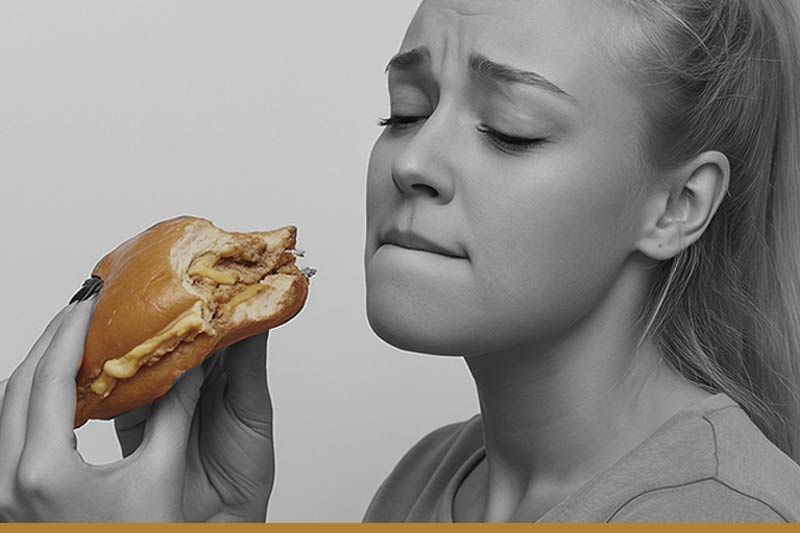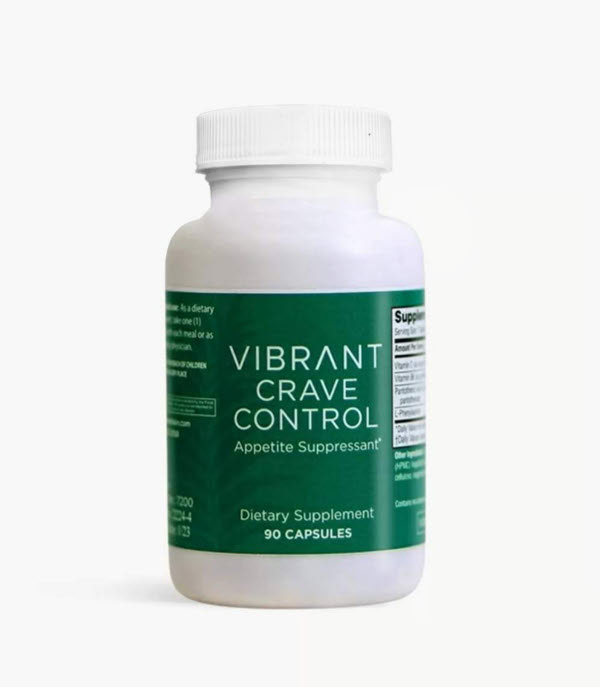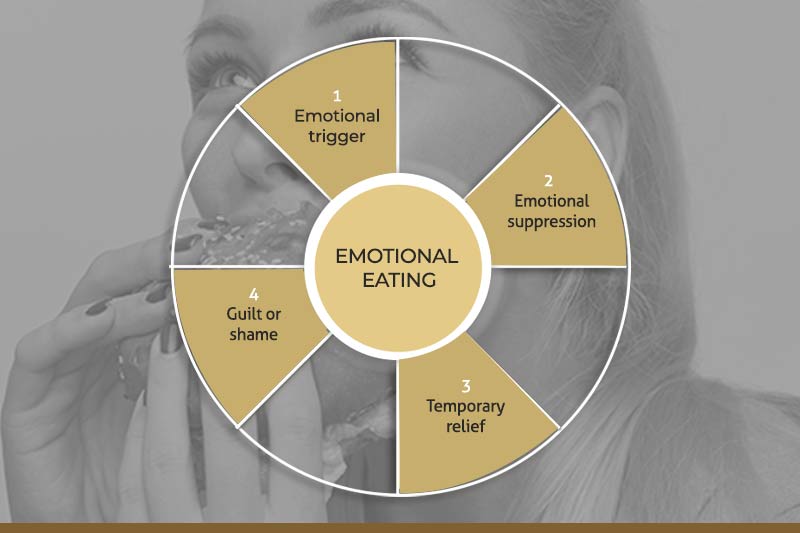Food nourishes both the body and mind, but it can also provide temporary relief from daily stress. How we process emotions, interact with others, and cope with anxiety, worry, or boredom can influence our eating habits. So-called “comfort foods” can quickly become a go-to coping mechanism, creating a cycle of emotional overeating whenever we face discomfort.
This article explores how to recognize emotional eating and provides practical strategies to mitigate its long-term health effects.

Emotional eating is a learned coping mechanism used to manage uncomfortable emotions, such as stress, sadness, anxiety, boredom, or loneliness. It can be triggered by everyday pressures or major life events, like job loss, divorce, or the death of a loved one.
People reach for high-calorie, fatty, or sugary foods to comfort themselves, distract themselves from negative feelings, or suppress unresolved emotional pain or trauma. However, they may also eat to intensify or prolong pleasant emotions, such as happiness or joy.
While this behavior may provide temporary relief, it does not address the underlying problem. If left unaddressed, emotional eating may lead to weight gain, insulin resistance, type 2 diabetes, low self-esteem, guilt, shame, and gut-related issues like dysbiosis and inflammation.
Emotional and binge eating can overlap, but they are not the same.
Emotional eating is always triggered by difficult emotions that a person tries to suppress or assuage with comfort food.
Binge eating is characterized by a loss of control and often includes eating rapidly or consuming huge portions in one sitting. It is not always driven by emotions and tends to occur on a regular basis.
Binge-eating disorder (BED) is a severe mental health condition officially recognized by the American Psychological Association. Emotional eating can be a symptom of, or a risk factor for, BED and requires professional help if the problem persists or does not resolve on its own.
Emotions can both increase and decrease appetite, often overriding physical hunger cues and influencing what, how, and when we eat.
Scientists have discovered that stress leads to cortisol spikes that can stimulate appetite and trigger cravings for high-sugar, high-fat comfort foods. However, some individuals experience appetite loss during stressful situations. The stress-coping mechanism becomes automatic over time, especially if repeated often.
Research also shows that “positive emotions” tend to enhance appetite, while “negative emotions” either either increase or suppress it. The behavior depends on the person’s food preferences, early life experiences, sex, weight status, and the responses developed in early childhood.
Note: Discover the best appetite suppressants to manage cravings, such as Vibrant Crave Control.

Different psychological, physical, and circumstantial factors can trigger emotional eating. Identifying and addressing these underlying issues significantly reduces the risk of developing or reinforcing this behavior.
Psychological risk factors include:
Physical risk factors include:
Environmental and life circumstance triggers:
Note: Read about how hormonal imbalance impacts weight gain.

Emotional eating often follows a predictable cycle that reinforces itself over time. A person who eats in response to emotions typically experiences the following pattern:
An uncomfortable and overwhelming emotion arises. It can be fear, sadness, loneliness, anger, or boredom and acts as a cue, triggering a reaction (i.e., eating).
Food is used to suppress intolerable emotions, distract oneself, or calm down. The choice is typically unconscious and, over time, becomes an automatic coping strategy.
Eating brings a false sense of control and short-term comfort. This brief relief perpetuates the cycle and reinforces the unhealthy behavior.
Once the bout of emotional overeating is over, feelings of shame, guilt, and self-criticism set in. These negative emotions may even start the cycle again.
Emotional eating impacts both physical health and emotional wellbeing, often leading to shame, anxiety, weight gain, and digestive issues. It also interferes with daily life, affecting your relationships, productivity, and self-image.
Emotional dependence on food can produce the following long-term health issues:
Each person develops a unique behavioral pattern when it comes to emotional eating. Some prefer to eat late at night in private, while others turn to street food and have no problem eating in public. Identifying the exact habitual pattern is crucial to solving this problem effectively.
Common triggers include:
Distinguishing between emotional and physical hunger is crucial for establishing a healthier relationship with food. Identifying the cues will help you choose food in response to physical needs rather than using it to cope with stress.
The following lists will help you recognize the different hunger cues.
People who eat in response to emotions rather than hunger experience the following:
The following cues are typically a sign of physical hunger:
Comfort eating can become so deeply ingrained that breaking the habit feels nearly impossible. The good news is that you can regain control of your eating patterns, curb overeating, and create healthier habits with consistent effort.
The following guidelines can help you get back on track.
Recognizing the emotions and situations that trigger emotional eating is the first step toward change. Once you identify the people, places, or scenarios that spark unhealthy eating habits, you can begin to make more conscious choices.
One practical approach is to replace the automatic response with a healthier alternative. For example, if you're prone to road rage, instead of turning to fast food for comfort, try a calming breathing exercise to soothe your nervous system and create space to respond more mindfully.
A food diary can be a powerful tool for developing healthier eating habits. By tracking what you eat and how it makes you feel, you can identify unhealthy patterns, recurring emotional triggers, and the link between mood and food.
Your journal entries can include the following:
Learning how to manage stress helps you build mental resilience, lower cortisol levels, and establish a healthier approach to food. Prolonged stress disrupts hormonal balance, leads to unwanted weight gain, and thwarts your weight loss efforts.
These are the most effective stress-relieving practices:
A thoughtfully arranged environment reduces temptation, eliminates triggers, and helps to break unhealthy eating patterns, such as reaching for a bag of chips whenever you feel bored or upset. A clean, clutter-free kitchen encourages more mindful food choices. For example, replacing a cookie jar with a fruit bowl makes it easier to choose healthier options.
Remove all visible cues that prompt cravings. Keep snacks and sweets off the counter, and store comfort foods out of sight, such as on a high shelf or in a closed cabinet.
Emotional eating is a habit with the following behavioral pattern:
1. A cue (uncomfortable emotion)
2. Learned behavior (eating high-calorie, sweet, or unhealthy food)
3. Reward (temporary comfort)
Psychologists have discovered that you can break the loop by replacing the routine behavior (eating) with a healthier substitute. This is called habit replacement or habit substitution.
If you tend to reach for high-calorie foods to soothe anxiety, you can train yourself to choose a stress-relieving activity any time you feel anxious or overwhelmed. Over time, this substitution will help you respond to emotional triggers in a healthier, more constructive way.
Cravings are more likely to arise when you skip meals, eat poorly, or restrict yourself too severely. For example, a low-protein diet destabilizes your blood sugar levels, causing glucose spikes and increased hunger.
Regular, well-balanced meals that include protein, fiber, and healthy fats will keep you fuller for longer, stabilize blood sugar levels, and reduce cravings. Keep nutritious alternatives on hand and limit access to hard-to-resist snacks. However, avoid eliminating all treats, as strict restrictions can intensify cravings.
You should seek professional help if you feel powerless to stop or if you already have mental and physical health issues, such as unwanted weight gain, gut problems, or guilt and shame that you can’t control on your own.
A licensed nutritionist will tailor a healthy and sustainable diet that meets your dietary needs and eating preferences. A mental health professional can teach you effective coping skills for developing stress resilience. They can also help you address the root cause of emotional eating and discover whether you have an underlying eating disorder.
Eating to cope with painful emotions is a common experience, and you are not alone in this. However, understanding what triggers this behavior is the first step toward building a healthier relationship with food. Making lifestyle changes, seeking professional support, and choosing healthier and more nourishing foods will improve both your physical and mental wellbeing.
Contact our Vibrant Vitality Clinic team of professionals for more information on nutrition, diets, supplements, and healthy eating plans.




4325 E Indian School Rd, Suite 130
Phoenix, AZ 85018
United States
(480) 422-2058
info@vibrantvitalityclinic.com
Monday - Friday: 9:00 am - 6:00 pm
Saturday: 9:00 am - 3:00 pm
Sunday: Closed
